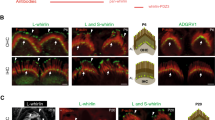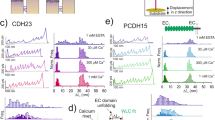Abstract
Hair cells of the inner ear are mechanosensors that transduce mechanical forces arising from sound waves and head movement into electrochemical signals to provide our sense of hearing and balance. Each hair cell contains at the apical surface a bundle of stereocilia. Mechanoelectrical transduction takes place close to the tips of stereocilia in proximity to extracellular tip-link filaments that connect the stereocilia and are thought to gate the mechanoelectrical transduction channel1,2,3. Recent reports on the composition4,5,6,7,8, properties and function9,10,11 of tip links are conflicting29. Here we demonstrate that two cadherins that are linked to inherited forms of deafness in humans12,13,14,15 interact to form tip links. Immunohistochemical studies using rodent hair cells show that cadherin 23 (CDH23) and protocadherin 15 (PCDH15) localize to the upper and lower part of tip links, respectively. The amino termini of the two cadherins co-localize on tip-link filaments. Biochemical experiments show that CDH23 homodimers interact in trans with PCDH15 homodimers to form a filament with structural similarity to tip links. Ions that affect tip-link integrity and a mutation in PCDH15 that causes a recessive form of deafness16 disrupt interactions between CDH23 and PCDH15. Our studies define the molecular composition of tip links and provide a conceptual base for exploring the mechanisms of sensory impairment associated with mutations in CDH23 and PCDH15.
This is a preview of subscription content, access via your institution
Access options
Subscribe to this journal
Receive 51 print issues and online access
$199.00 per year
only $3.90 per issue
Buy this article
- Purchase on Springer Link
- Instant access to full article PDF
Prices may be subject to local taxes which are calculated during checkout




Similar content being viewed by others
References
Corey, D. Sensory transduction in the ear. J. Cell Sci. 116, 1–3 (2003)
Gillespie, P. G. & Walker, R. G. Molecular basis of mechanosensory transduction. Nature 413, 194–202 (2001)
Hudspeth, A. J. How hearing happens. Neuron 19, 947–950 (1997)
Ahmed, Z. M. et al. The tip-link antigen, a protein associated with the transduction complex of sensory hair cells, is protocadherin-15. J. Neurosci. 26, 7022–7034 (2006)
Lagziel, A. et al. Spatiotemporal pattern and isoforms of cadherin 23 in wild type and waltzer mice during inner ear hair cell development. Dev. Biol. 280, 295–306 (2005)
Michel, V. et al. Cadherin 23 is a component of the transient lateral links in the developing hair bundles of cochlear sensory cells. Dev. Biol. 280, 281–294 (2005)
Siemens, J. et al. Cadherin 23 is a component of the tip link in hair-cell stereocilia. Nature 428, 950–955 (2004)
Sollner, C. et al. Mutations in cadherin 23 affect tip links in zebrafish sensory hair cells. Nature 428, 955–959 (2004)
Kachar, B., Parakkal, M., Kurc, M., Zhao, Y. & Gillespie, P. G. High-resolution structure of hair-cell tip links. Proc. Natl Acad. Sci. USA 97, 13336–13341 (2000)
Sotomayor, M., Corey, D. P. & Schulten, K. In search of the hair-cell gating spring elastic properties of ankyrin and cadherin repeats. Structure 13, 669–682 (2005)
Tsuprun, V., Goodyear, R. J. & Richardson, G. P. The structure of tip links and kinocilial links in avian sensory hair bundles. Biophys. J. 87, 4106–4112 (2004)
Ahmed, Z. M. et al. Mutations of the protocadherin gene PCDH15 cause Usher syndrome type 1F. Am. J. Hum. Genet. 69, 25–34 (2001)
Bolz, H. et al. Mutation of CDH23, encoding a new member of the cadherin gene family, causes Usher syndrome type 1D. Nature Genet. 27, 108–112 (2001)
Bork, J. M. et al. Usher syndrome 1D and nonsyndromic autosomal recessive deafness DFNB12 are caused by allelic mutations of the novel cadherin-like gene CDH23. Am. J. Hum. Genet. 68, 26–37 (2001)
Di Palma, F. et al. Mutations in Cdh23, encoding a new type of cadherin, cause stereocilia disorganization in waltzer, the mouse model for Usher syndrome type 1D. Nature Genet. 27, 103–107 (2001)
Ahmed, Z. M. et al. PCDH15 is expressed in the neurosensory epithelium of the eye and ear and mutant alleles are responsible for both USH1F and DFNB23. Hum. Mol. Genet. 12, 3215–3223 (2003)
Assad, J. A., Shepherd, G. M. & Corey, D. P. Tip-link integrity and mechanical transduction in vertebrate hair cells. Neuron 7, 985–994 (1991)
Halbleib, J. M. & Nelson, W. J. Cadherins in development: cell adhesion, sorting, and tissue morphogenesis. Genes Dev. 20, 3199–3214 (2006)
Boggon, T. J. et al. C-cadherin ectodomain structure and implications for cell adhesion mechanisms. Science 296, 1308–1313 (2002)
Buchel, C., Morris, E., Orlova, E. & Barber, J. Localisation of the PsbH subunit in photosystem II: a new approach using labelling of His-tags with a Ni2+-NTA gold cluster and single particle analysis. J. Mol. Biol. 312, 371–379 (2001)
Anniko, M. & Wroblewski, R. Ionic environment of cochlear hair cells. Hear. Res. 22, 279–293 (1986)
Brieher, W. M., Yap, A. S. & Gumbiner, B. M. Lateral dimerization is required for the homophilic binding activity of C-cadherin. J. Cell Biol. 135, 487–496 (1996)
Pokutta, S., Herrenknecht, K., Kemler, R. & Engel, J. Conformational changes of the recombinant extracellular domain of E-cadherin upon calcium binding. Eur. J. Biochem. 223, 1019–1026 (1994)
Patel, S. D. et al. Type II cadherin ectodomain structures: implications for classical cadherin specificity. Cell 124, 1255–1268 (2006)
Phillips, K. R., Tong, S., Goodyear, R., Richardson, G. P. & Cyr, J. L. Stereociliary myosin-1c receptors are sensitive to calcium chelation and absent from cadherin 23 mutant mice. J. Neurosci. 26, 10777–10788 (2006)
Senften, M. et al. Physical and functional interaction between protocadherin 15 and myosin VIIa in mechanosensory hair cells. J. Neurosci. 26, 2060–2071 (2006)
Schneider, M. E. et al. A new compartment at stereocilia tips defined by spatial and temporal patterns of myosin IIIa expression. J. Neurosci. 26, 10243–10252 (2006)
Siemens, J. et al. The Usher syndrome proteins cadherin 23 and harmonin form a complex by means of PDZ-domain interactions. Proc. Natl Acad. Sci. USA 99, 14946–14951 (2002)
Gillespie, P. G., Dumont, R. A. & Kachar, B. Have we found the tip link, transduction channel, and gating spring of the hair cell? Curr. Opin. Neurobiol. 15, 389–396 (2005)
Acknowledgements
We thank M. Sotomayor for discussions regarding cadherin ectodomain structure. We thank members of the Müller and Kachar laboratories for comments. This work was supported by the NIH (U.M., R.A.M., E.M.W.-K., and H.S., J.T., B.K. (intramural funding)). Negative staining TEM analysis was conducted at the National Resource of Automated Molecular Microscopy.
Author Contributions U.M. and B.K. supervised the project and contributed equally as co-senior authors. P.K and H.S. are co-first authors. H.S. and J.T. characterized the antibodies and carried out the experiments in Fig. 1 and Supplementary Figs 1, 2 and 3. P.K. carried out the experiments in Figs 2–4 and Supplementary Figs 1, 4, 5 and 6. P.K. provided the proteins for negative staining TEM, which was carried out by E.M.W.-K.
Author information
Authors and Affiliations
Corresponding authors
Ethics declarations
Competing interests
Reprints and permissions information is available at www.nature.com/reprints. The authors declare no competing financial interests.
Supplementary information
Supplementary Figures
This file contains Supplementary Figures S1-S6 with Legends. (PDF 4109 kb)
Rights and permissions
About this article
Cite this article
Kazmierczak, P., Sakaguchi, H., Tokita, J. et al. Cadherin 23 and protocadherin 15 interact to form tip-link filaments in sensory hair cells. Nature 449, 87–91 (2007). https://doi.org/10.1038/nature06091
Received:
Accepted:
Issue Date:
DOI: https://doi.org/10.1038/nature06091
This article is cited by
-
Emergence of slip-ideal-slip behavior in tip-links serve as force filters of sound in hearing
Nature Communications (2024)
-
The Piezo channel is a mechano-sensitive complex component in the mammalian inner ear hair cell
Nature Communications (2024)
-
Transient interactions drive the lateral clustering of cadherin-23 on membrane
Communications Biology (2023)
-
Protocadherin 15 suppresses oligodendrocyte progenitor cell proliferation and promotes motility through distinct signalling pathways
Communications Biology (2022)
-
Selective binding and transport of protocadherin 15 isoforms by stereocilia unconventional myosins in a heterologous expression system
Scientific Reports (2022)
Comments
By submitting a comment you agree to abide by our Terms and Community Guidelines. If you find something abusive or that does not comply with our terms or guidelines please flag it as inappropriate.



